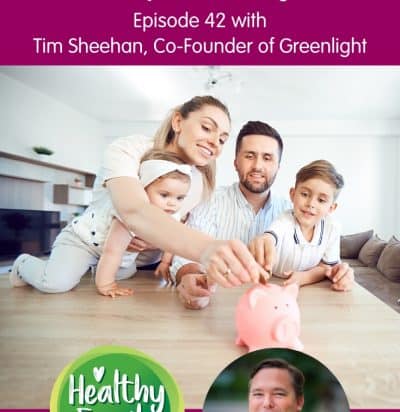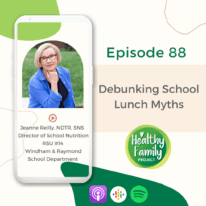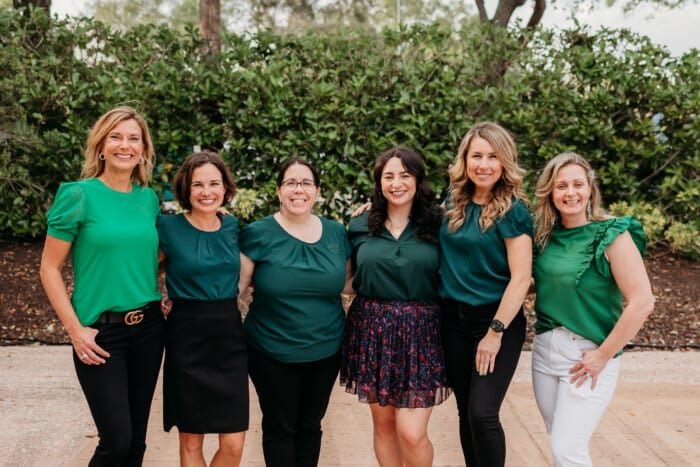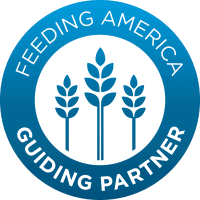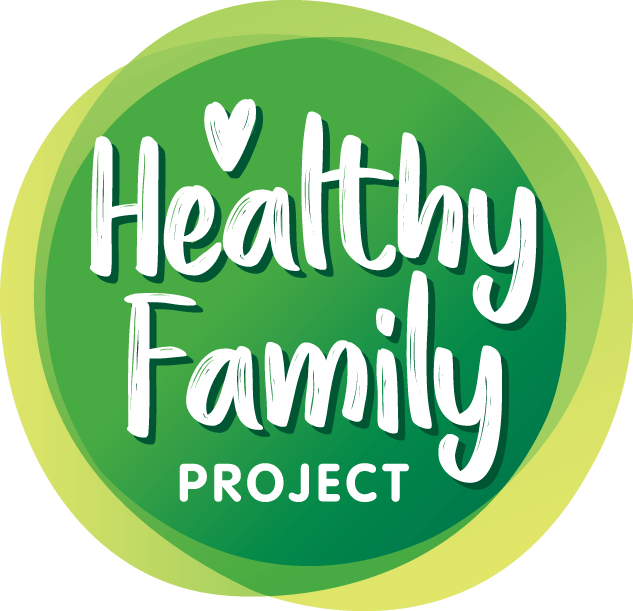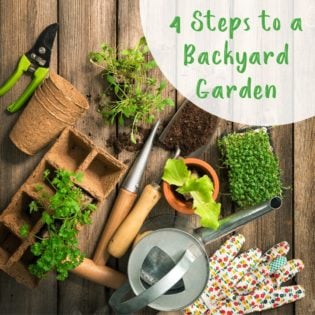Episode 42: Teaching Kids Financial Responsibility
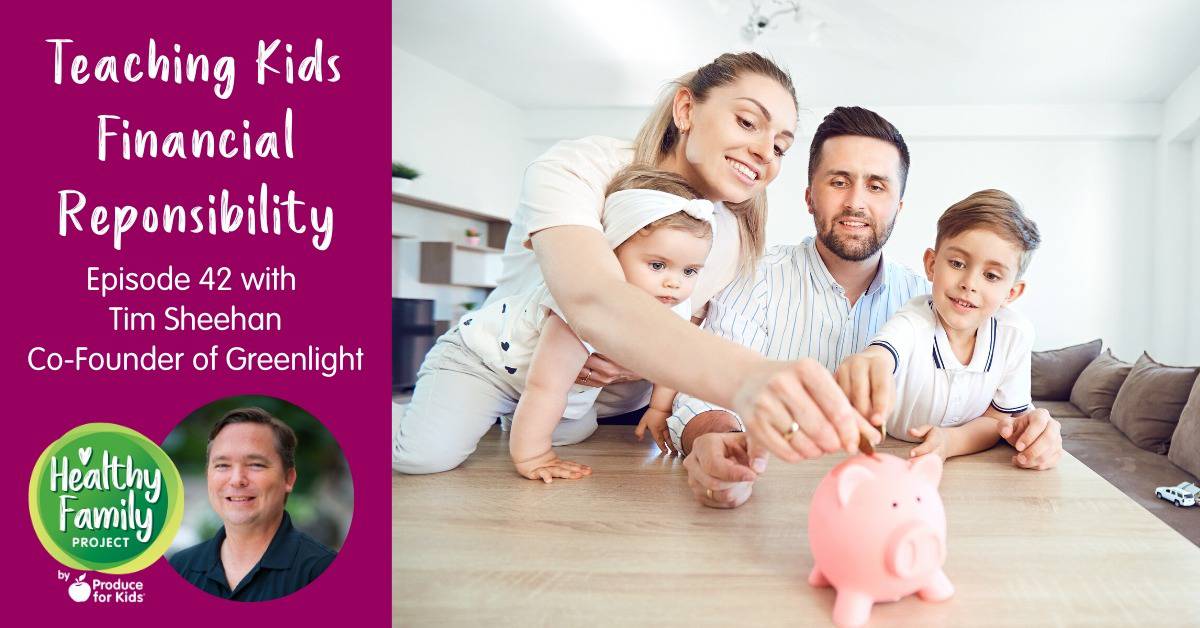
In this episode of the Healthy Family Project, we talk to Tim Sheehan, co-founder of Greenlight all about teaching our kids how to be financially responsible.
It seems like financial responsibility is one of those skills that we don’t think we need to tackle until our kids are in their teens, but it’s important to start talking about finances early.
Tim shares tips to help parents teach their kids about managing money from a young age, including the pros of allowances and how the Greenlight Card can help.
Tim Sheehan is the Co-Founder and CEO of Greenlight. Greenlight is the safest way for parents to give their kids money, approve their spending, and prepare them for financial independence.
Prior to Greenlight, Tim was the Lead Entrepreneur In Residence at Georgia Tech’s startup incubator, the Advanced Technology Development Center. Earlier in Tim’s career he was Director of Yahoo! Finance and responsible for growing it to the #1 finance site in the world.
Tim also served as SVP Products, Marketing and Strategy for Biller Solutions at Fiserv, was a Cofounder & CEO of Reachable, General Manager of Yodlee, and Senior Product Manager at E*Trade.
About Greenlight
Greenlight is a debit card for kids, teens and college students that parents can manage with the Greenlight app using flexible parental controls.
Since 2017, Greenlight has helped more than half-a-million parents and kids manage their finances by giving parents the tools they need to teach their children how to spend wisely, the importance of saving and how to make responsible financial choices.
Listener Survey!
Thank you so much for supporting the Healthy Family Project Podcast! We’d love it if you could take 5 minutes to let us know how we can bring you the best possible content for future episodes. Take the survey here.
Healthy Recipes & Tips in Your Inbox
Sign up for the Healthy Family Project e-newsletter to receive healthy recipe inspiration, our latest blog posts and more directly to your inbox each week.
Healthy Family Project Facebook Group
Join our Healthy Family Project Facebook group! This group will serve as a safe space for parents and caregivers to talk all about raising a healthy family – from dealing with a picky eater and tips to get more fruits and veggies onto plates to exercising as a family and mental health. We welcome all of you to join in!
Want to skip straight to a hot topic? See time stamps below. But of course, we recommend listening all the way through!
- 3:32 How the idea for Greenlight started
- 7:27 Capabilities of Greenlight card
- 13:30 Allowance and chore capabilities through the app
- 16:14 How & when to start teaching financial responsibility to kids
- 21:43 Perks of allowances
- 25:25 How to prepare your teens for the real world
- 31:20 How to help our kids from getting into future debt
- 37:54 What does a healthy family mean to you?
Relevant Links
- Learn more about the Greenlight card
- Follow Greenlight on Instagram
- Money Skills to Teach Your Kids
- Find the Greenlight Card app on Apple App Store or Google Play
Other Podcast Episodes to Check Out:
- Episode 35: Helping Kids Make Good Choices
- Episode 31: Balancing Career & Family
- Episode 24: Making Exercise a Family Affair
- Episode 19: Promoting Positive Body Image with Kids
Healthy Family Project Podcast
Conversations covering hot topics in the world of health, food and family with a dose of fun. Helping families ease their way into a new fresh and healthy world.
Be on the lookout for new bi-weekly episodes and don’t forget to subscribe on Apple Podcasts, Google Podcasts, Spotify or your favorite podcasting site. If you like an episode, make sure to leave a rating and comment.
If you are interested in being a guest on the Healthy Family Project podcast, contact amanda@healthyfamilyproject.com with your topic idea for consideration.
Transcript for Episode 42
This transcript was produced by Otter.Ai. Please forgive any misspellings and grammatical errors.
00:15
Welcome to the healthy family project by produce for kids, covering the hot topics in the world of health,
food and family with a dose of fun. Today, we are talking to Tim Sheehan, co founder of Greenlight all
about teaching our kids how to be financially responsible. As parents, we all work really hard to set our
kids up for success from the very beginning. We have big expectations, and we just want them to be
successful. So everything from in the beginning we’re teaching our toddlers to say please, and thank
you, you know, to be socially responsible on the playgrounds, and teaching them about Stranger danger,
and then on to getting them to tutoring for a class, they might have trouble with setting them up for
academic success, teaching them how to eat the right foods to have nutritional success. And I mean, the
list really goes on. But then we think about financial responsibility. And it kind of continues to be
something that slips off the radar. Many of us don’t want our kids to be burdened thinking about finances
at a young age, right? Like save that adulting for later. Or maybe it’s something like we don’t want our
kids to worry the way we might have had to worry about money as a child. So whatever the reason might
be, or if it’s just something that’s just not on the radar. Regardless, you know, we’re doing our kids a huge
injustice if we don’t look for ways to help them become financially responsible. And I don’t mean, as
teenagers either. I think it can really start at a young age, setting the groundwork for that. So Greenlight
is something I started using with my older daughter recently. And basically, basically, Greenlight is a safe
way for parents to give their kids money, approve their spending kind of this just a way for them. If they’re
making money to have their money in one spot. I know that not a lot of us carry cash all the time. So this
is just a great way to prepare them and give them visibility into you know where their money is going and
really preparing them for financial independence. So Tim is the data for kiddos. And besides that,
because that’s that’s a lot right there. He has a lengthy resume behind his Greenlight venture. Tim was
the lead entrepreneur in residence at Georgia Tech startup incubator, the Advanced Technology
Development Center. And earlier in Tim’s career, he was director of Yahoo Finance and responsible for
growing it to the number one finance site in the world. Tim also served as SVP of Product Marketing and
strategy for biller solutions at Pfizer, as M was a co founder and CEO of reachable general manager at
yo Li and Senior Product Manager at E trade. So if there’s anyone who has the know how to create
something awesome for kids and parents in the finance space, I think it’s definitely Tim. Welcome to the
healthy family project. Tim, can you give us a little background and ground on how you came up with the
idea for Greenlight and why you chose to pursue it?
03:27
Sure, sure. Thanks, man. Thanks for having me. Yeah, it’s goes back. I guess, five years now, I have four
kids, two boys and two girls, okay. And I was experiencing the as most parents are the kind of, you know,
we’re making most of our purchases with debit cards and credit cards. And so my wife and I were not
carrying cash with us as frequently as we used to. And yet, we still had lots of circumstances or cases
where we needed to be able to give our kids money, whether that was for a school field trip, or a traveling
sports team, or, you know, just go to the movies with their friends. All kinds of different scenarios pay in
allowance. And so we were constantly in the situation where we were either needing to run to the ATM or
borrow from one sibling to give to the other. I do that. So, in my head, I was like, I know that there’s a
better way to do this. Let me let me try to find out if you know most parents are having this kind of same
challenge. And so that’s where it all started was kind of personally experiencing this, this kind of not
carrying cash it needed to be able to give our kids money. And then I spoke with about 100 other parents
and then eventually 2000 parents via survey nationwide And long story short, most parents were having
this this same problem. And then, but what wasn’t what was interesting is in talking to them, they not only
wanted to solve this kind of, you know, convenience problem, but they also wanted their kids to be smart
about money overall. And so that’s what really led to the mission of green light and kind of got me really
excited and motivated. And so that’s what we’re all about is trying to help parents raise financially smart
kids.
05:33
Well, I certainly appreciate it. And we chatted for a couple of minutes before hopping on here. But I said
the universe had to know something new that you were meant to be on the podcast, because I actually
just started using the greenlight card with my daughter this year, she’s an eighth grade. So she’s gonna
be 14 in a couple months, and she start has started making some babysitting money. And you know,
we’ve been giving her money for different chores. And so I was finding one she was, you know, with
cash, I just, she’s sometimes not the most organized person. She’s just she listened to the podcast now.
So I’m trying to be really careful. So sometimes she, as all of us humans, is not so organized and was
kind of misplacing things. And, you know, money was coming in. And so in my research, I came across
green light. And she was also planning a trip with the school her course group to go to Nashville. And so
I felt like, well, I need the ability to add funds, something were to happen, you know, so I came across the
greenlight card, I was doing my research, I really love that she has access to the app, and I can see her
spend, and she can see your spend and savings. And I knew I’d made the right choice. This was like my
yes moment when she called me from Nashville and said, I really want to buy this Kacey Musgraves t
shirt. But I feel like maybe my funds, I don’t have enough in there, do you think I’m looking at like what I
need for meals the next day? So I felt like that’s a magical moment. She’s actually recognizing, you
know, so if you could just talk a little bit about, you know, the capabilities of the card. And you know,
what, what we’re able to do with it?
07:20
No, that’s fantastic. I love hearing that example, because you’re right, like, I think most parents after they
start using green light, it’s my favorite email to get is, is it’ll usually, it’ll cover a kind of a magical moment,
like you’re talking about where where the kids essentially demonstrate, you know, even without realizing
it, they show the parent, that they perhaps made a trade off decision on something like, whereas maybe
in the past, you know, they would just buy whatever’s in front of them or ask to buy something in front of
them. But now they’re starting to think about, well, maybe I don’t really need that. And I’ll save my money
for this better thing, you know, for something better later. Or either doing exactly like you said, and
starting to somehow think about the future like, Well, what about, you know, I’m gonna need some
money for meals tomorrow. So actually, I don’t know if I can buy this t shirt. But yeah, so I, I appreciate
you sharing that, because I love hearing those moments. But But yeah, greenlink, the way to think of it is
it’s essentially four accounts all kind of built into one simple app. And so And essentially, the parent gets
to use the app, and the parent is kind of the super user, they, they have control over everything. And then
the child also gets to use the app on their phone, and they can make requests of the parent, and they
can see their balances. But when I say four accounts, it’s essentially a spending account with parental
controls, number one, number two, it’s a savings account, where they can have savings goals, and track
their progress towards savings goals. And then of course, you know, save their money. So there’s a
savings account there. And then there’s also a parent paid interest that can be added to kind of incent
the child to save. And what’s neat about that is the parents are really using it and the kids love it. Like I
think yeah, we just crossed $17 million that the kids have saved on Greenlight, Madison. Yeah, and I just
found that out this morning. And then the average interest rate that the parents have set is 18% API,
which is quite high, that is high. But it’s also great, you know, because if you really want kids to learn to
save and to form that that healthy financial habit of saving, then you want to incent them, right you want
to really provide a strong incentive for them to save. And then when they start doing it, and they just start
saving because of this incentive you put in place Before you know it, they it becomes their habit, it just
becomes the norm that they’re going to save their money. And, and so then even when they you know,
they’re out on their own in the real world, as an adult, you know, they’re there kind of default habit is to
save. And so anyway, so that’s that’s kind of the the second big component or second account that’s built
in there as the savings account. And then the third one is a giving account. So for the families that want
to teach their kids to give back, there’s a giving account so that kids can give to Nonprofits and Charities
through that. And then the fourth is an investment account. And that’s the piece that’s coming in the in
the new year, probably in q1. So it’s this spending account, savings account, giving account and
investing account all built into one.
10:49
I love it. And I like that. Also, you know, it’s so simplistic to use because I kept thinking, do I really need
another card? Or do I really need something else to manage, like, manage so many things with my kids?
Like, yeah, how can I add something into that mix, but I felt like when I went into the app, I was like, this
is really simple. Like I can immediately hear that, yeah, just go where I need to go. There’s not a lot of
extra things. I think a lot of times with apps and things like this. developers tend to like give you
everything you need, but you’re like, what all of those things. I just
11:26
like they overdo it a little bit. Yeah, I, I tried to appreciate you saying that. Because I did, I wanted to keep
it super simple. And just kind of recognize that, you know, the parent parents are busy enough already,
we do not need them spending time trying to navigate our app, like let them accomplish what they’re
trying to do really, really quickly, and move on to the next thing because they’ve got, you know, a million
things competing for their time in a given day. So I appreciate you saying that.
11:56
Right. And then the other thing is, I noticed, you know, when we started using it, you get alerts, whenever
there’s a there’s a spent, so when she was away, that even though you know, I was busy working or
doing whatever I was doing, I would get that alert and recognize, like, okay, like mentally I know, she’s
not at a spot that I need to, you know, send money her way. At this point. I was kind of seeing what she
was spending her money on. So that I felt like that was a nice added. Yeah,
12:26
it is. It’s really handy. I love seeing it because I’m like, oh, Sydney is at Waffle House. I’m like, Alright,
Jack just bought some books at the bookstore. But yeah, I love seeing those as well. And we’ve heard
that from from really lots of parents that. And I love also, parents also say and I love seeing when they
attempted to use the car.
12:51
Yes, exactly. So it’s kind of funny, and I was just actually playing around with it a little more today. Like I
said, we’re not too far into it. But we haven’t gone down the path of the chores just yet. But I did notice
that you can set up either kind of like an irregular allowance deposit or a one time chore, which I like that
I was thinking, You know what my car really needs vacuum? Maybe I should set up at one time. Sure.
And, you know, the payment in here and see, see what happens?
13:24
Yeah, that’s exactly it, we were trying to, you know, for the families that do the do kind of weekly chores,
you know, allow a way for them to track that. And if they choose to, they can link it to a weekly allowance,
or, you know, monthly allowance, whatever, whatever they choose. And then you can also Yeah, exactly,
like you said, you can do the one off chores. And it’s hilarious. My my youngest boy, he’s 10 is always
coming up with suggested chores that he could complete for $5 or something. And the one he keeps his
go to, is to wash my car. And you know how that goes, it ends up like taking more effort from you than
from him. And and, and for some I don’t know how but the car seems to be dirtier after he’s tried to clean
it. But but but, but yeah, the whole point of that was to, you know, kind of help kids learn that, you know,
money doesn’t grow on trees, you have to earn money. And so we wanted to have that ability kind of built
into the app as well.
14:39
Well, I certainly love it and I’m looking forward to seeing what kind of chores I can come up with to add in
there.
14:46
And if the kids one another nice thing is if the kids are older, like say they’re they’re you know 1516 1718
And if they have a job, their direct deposit from their job can go right on to like cars Yeah, that’s that’s
another nice thing that’s built on there as well.
15:04
Awesome. So I know, you know, your background is in finance, obviously, you’re passionate about
helping, you know, families and kids move into the next chapter of their lives in a way that is, you know,
financially freeing, I guess, if you will. So, you know, some kids receiving allowance, they come home
with field trip forms, or bookfair requests, but of course, being that they’re so young, they don’t really
understand how it works, or the transaction behind it. You know, I feel like every day of the week, it’s like,
oh, it’s time for the yearbook. It’s time for this theater. Yes, sir. It’s time for this. And so you just pay pay
pay? And sometimes they think it just, you know, this is just like the Bank of, you know, yeah, mom. So
what are your thoughts? How do parents start to teach their kids about money, and how to manage it,
and what’s a good age to start these conversations?
15:57
You know, it’s what the, the way that we built Greenlight is, is to try to help with exactly that. So we, we
kind of, essentially, I, the way that I think it works best is, essentially teach them different things,
depending on the age that they’re at. So you can really engage them at a very young age, and, and the
focus could be on saving. And so that’s why we built, we put in the savings goals, and the, you know, it
kind of visually tracks your progress on that goal. And so, you know, you could even start with really
young kids, where all you’re doing is showing them that they’re saving their money, and, and they’re, you
know, if they’re saving toward, you know, a puppy or a tablet, or whatever it might be, they can see their
progress toward that. And then you can actually show them, you know, as they’re ready to start to do
some chores, you could start to incorporate chores, tracking into it. So really nothing to do with spending.
So, because in the in those really early years, right, the kids are not going to be off on their own, you
know, without their parents. So I the, the way that I would do it is is with the real young ones, who aren’t,
you know, off spending away from the parent, I would start with a focus on savings and learning about
money and how, with the parent paid interest, you can show them that, hey, as you save your money,
you’re getting this, you know, parent paid interest, you’re getting rewarded for saving your money. So my
youngest, his his way of referring to interest, because he can’t remember the word is, is free money. He’s
like, I like that free money that that green light has. And I was like, yeah, yeah, he’s talking about the
savings interest. But yeah, I think when they’re really young, you can focus on teaching them how to
save their money, that you need to earn money. And so hey, if you do this job, you know, you wash the
car, or you kind of complete this chore, you know, there’s a reward for that you can earn money that way.
And then as they start to get older, you you know, and it’s really tense to be around middle middle school,
I think, is when kids will start spending some time away from the parents, you know, just for a little while,
maybe after school or something like that. And so, you know, you might, you might have the ability to
say, okay, you know, you have $20 to spend for the week, you know, manage your money carefully, you
know, because if you go to the ice cream store on Monday and Tuesday, you you may not have anything
left for the whole rest of the week, and you start to try to teach them like a basic concept of a budget.
And that’s, that’s what I like about the allowance is is with, it’s funny with the two of my kids are savers
and don’t spend very much and two of them are like drunken sailor spenders. Just they will they’ll spend
on anything in front of them. And, and so with them, I found the allowance feature really handy because I
could say, Okay, you get x dollars per week, you know, don’t ask mom or me for any more money. That’s,
that’s what you get. And you have to kind of manage it yourself. Right? For you know, the different things
you might want to do. But yeah, but But to answer your question, I think when they’re really young, it’s it’s
about savings and, and understanding how you have to earn money for completing work or chores. And
then as they get older, you start to leverage some of the spending components with the parental controls
where essentially the parents can choose the exact stores that their kids can spend that so you can
really, you know, kind of have guidance and oversight of what the kids are doing. And, and then you
know, as they get older, and you know, they’ve learned a lot of these concepts, you know, you can, you
can pay less attention to it right, because they’re now you know, spending responsibly and you’re just
kind of watching the alerts come in and see where they’re spending it. But, yeah, I think I think it’s the
thing I’m excited about next is investing because I think that’s like another really core important piece of
the picture to teach your kids to invest, because that’s how they’ll build wealth over the long term. But it
really does work for ages, all ages have kids, like I mentioned, you know, Wes is 10, but I have my oldest
Jack is 20. And he, you know, he’s at college, and,
20:52
you know, so it’s nice to be able to go, you know, the books for school for college can be very expensive.
So I might say, Okay, well, here’s $400 for books, but I can tie it to, you know, the the university
bookstore. So that’s the only place that the money can be spent at it. So there’s just there’s all kinds of
features like that built into greenlight to recognize that, you know, when parents, for example, give
money, they may want the change to automatically be returned to them, or they may want the change to
go into the kid savings account. There’s all kinds of features like that built in.
21:28
I love that. Well, I think you made a good point about the allowance, because I think sometimes over the
years talking to other parents, it’s like, Oh, I’m not giving them an allowance. You know, what, what am I
going to give them an allowance? I’m not just going to give them money every week. But if you do it, I
think in a way, like you said, like, this is what you have to spend for the week. And yeah, you figure it out.
And when it’s gone, it’s gone. So I think that that it flipping that way is a really great teachable moment,
especially because I do also I have one saver and one spender. And so I think for my spender she would
benefit from we don’t currently do an allowance, but I’ve been on the fence about it. And I think that that
that makes total sense. I mean, she’s the one, I give her $20 And she goes to the food truck and buy
snow cones for everybody in line.
22:23
I mean, everybody does exactly my situation. Yes, yes, exactly. I think they had their really work. Yeah, it
really worked. Man, I can tell you because that it was funny. Like we were we were stumped. My wife and
I and we were like, I mean, because what happened is every day she would come ask for more money.
This was my youngest daughter and youngest son, they both they both would they would just ask for
money and it kind of like endless requests. And so we we finally realized, okay, actually, we need to put it
back on them to manage. And so that’s because we didn’t really do allowances before we encountered
the situation with those two. And so we were like, Okay, well, we we definitely need to start doing
allowances, because it’s the only way that they’re going to learn how to live within a fixed amount of
money, right. And the more I thought about it, the more excited I got about it, because I started to think,
you know, when they graduate from college, or they’re, they’re an adult on out on their own, you know,
they’re probably not going to be making a lot of money as their first job. And they’ll have all these
expenses that they have to pay. And if they can learn at an early age, how to live within a, you know, live
within your means. That’s a really important concept. That’s a really important thing. If, if, if the budget is
even, you know, $10 or $20. It’s kind of like a microcosm of the of the bigger world, you know, when
they’re going to be out there with, you know, $1,000 to cover all of their expenses. And knowing how to
kind of live within your budget is a really, really important concept to learn at a young age, I think.
24:13
Yes. And I think that that kind of touches in on the next question that I had, which if you have anything
else to add, because I think we’ve covered most of it, but what are some ways parents can prepare their
teens for the real world? I know when I went off to college, I think my parents prepared me I had a lot of
financial responsibility growing up. And I think maybe just some of the things that shocked me were
maybe like, you know, my first house that I lived in with roommates, like our electric bill came, you know,
what’s this? Like, this is a lot of money. So do you have anything else I guess to add, like what life looks
like when you leave your parents house when it comes to financial responsibility? I get sometimes like I
don’t want to keep harping on you know, like, get out out of the shower, like I pay for that water. Like, I
don’t want to keep paying that parent, but I don’t know, like, where the line is where I’m like, am I saying
enough for my thing too much?
25:09
Yeah, yeah, yeah, no, I think I think it’s one thing is definitely that concept of learning how to live within
your means is an important thing to learn, I think so whether you do that through an allowance, or you do
it through another method, and that’s the other thing is every family can can, you know, find their own
pathway through and we tried to structure Greenlight in a way where it was really flexible, and kind of,
you know, no matter how you did things, you could, you know, green light could work for you. And I think
so that’s one thing. So even though like we were a family, where, you know, the way I grew up was, you
just did chores, because you were part of the family, there wasn’t any allowance. And so, you know, that
was just how it was. And so when I had kids, we didn’t do allowances, because that was how I was
raised. But it was really this kind of special situation where I had a daughter and a son, where I was like,
wow, you know, this is really tricky. They’re, they’re not learning what I’m trying to get them to learn. And
so putting them on an allowance that did that did help them learn what I wanted them to learn. And, and
so yeah, I think learning that ability to live within your means is a huge one. I’d say, if you as they get
older, if you can start to show them, you know, the types of bills that you pay, I think it’s helpful for them
to understand that. Because the one thing I’ve learned is they don’t really actually realize how many bills
we pay as parents or as adults. And, and so, you know, they might be aware of a couple like, oh, you
know, you pay the mortgage, or, you know, for a car loan or something. But they may not be aware of all
of the others, like, oh, we pay the water bill, we pay, you know, the power bill, we pay the cell phone bill,
we pay for internet, we pay, you know, I mean, there’s a lot of bills that add up. And so I think that can be
helpful to, for them to get a sense of, you know, how much, you know, you you have to pay for as an
adult, there’s a lot of costs. And, and then I think, you know, building those important habits, I mentioned
saving, I think that’s probably a critical one to try to have them learn really early, is that saving their
money by default is kind of a really important habit to build. Because unexpected things happen in life,
like when you’re out on your own the car, your car may need some work, may need repairs. And that
might be an unexpected expense that’s not in your budget, and having some savings set aside to handle
that unexpected expense is really important. And so yeah, and then I as I mentioned earlier, I think
learning how to invest is important too, because that’s, that’s really how they’ll build up their nest egg. For
when you know they’re ready to retire or for when they are ready to make a significant purchase in their
life. But those are the things that jumped to my mind.
28:18
Right? I’m excited for that launch. That’ll be my my daughter Mia. She’s, like I said eighth grade. She’s
going to be 14 in the new year. But I think it’ll it’s the perfect time for her probably to kind of go down that
path as long as as long as she stops buying snow cones for everyone in the line.
28:37
That’s so funny. I love that story. Because my my youngest daughter she she was doing the same thing
at at the ice cream store was a Dairy Queen is that Dairy Queen? She’d be like, Oh, I can it’s okay, you
don’t have money, I’ll get yours right and funny. And it was hard to be upset because she was being
generous, you know, which you you want to encourage and your kids but the same. You’re like, well, you
can’t really be spending this amount of money every day. So anyways, yeah, I think you know, we all all
do the best we can but I with Greenlight, I just wanted to try to kind of, I don’t know, make it a little bit
easier on the parents to impart some of this knowledge to the kids.
29:22
Yes, well, I like I said, I’m definitely definitely enjoying it so far with me. I feel like next year, we’ll be able
to to even do more and as her babysitting jobs pick up she’s been handing over the cash to me and just
saying hey, can you put this you know, I’m gonna keep a 20 Ami, but can you take this and just put it in
and then she she’ll go in and divvy it up on her own. So so before we wrap I have to talk about this. So
debt is obviously a huge problem in this country at all ages. And I know that being out on your own for
the first time and that that Russia freedom hits you. I remember being on the University of Pittsburgh
campus freshman year, and I felt like every turn on campus, there was like a table with someone
shoveling a credit card in my face. Yeah. And I, I didn’t, I didn’t have a credit card until probably my
senior year, I think because my parents said, Well, you need to start building your credit, because, you
know, next year when you’re going to get an apartment on your own, or, you know, buying a new car or
whatever you’re going to need to, to have that setup. So, you know, I just worries me, you know, thinking
back to then like I didn’t, but I knew I had lots of friends. Let me tell you who signed up for that card? And
yeah, I would be buying drinks and spending, you know, let’s go do this. Oh, I can I can, you know, I kind
of see buying all of the snow cones in the line parlaying certain things habits, and I’m like, no. So let’s
say, you know, what are your tips about how we try to keep these young folks out of going into that debt
problem?
31:07
Yeah, yeah, I think. Yeah, I remember seeing one statistic where I think it was in 2018, I think I think it
was like 870 billion of credit card debt in the country. And I was just a member that blew me away,
because it was almost a trillion. And yeah, I think, you know, the that that’s why, by the way, we make
greenlight a debit card, and not a credit card, is we wanted the kids to learn to spend what you have, and
not what you don’t have. And so, I think that that’s a really important thing, right? It’s just as they as they
grow, learning that, hey, if you don’t have the money, you can’t spend it, you have to earn it, or you have
to have saved it. And then and then you can make your own decisions about what you buy. So I think
that it’s, it’s one of the big reasons why we’re doing Greenlight is I don’t want, I don’t want kids to end up
in, you know, credit card debt, or, or have a bad credit score, or, you know, have no savings set aside,
and, and an unexpected expense, you know, knocks them off balance or, you know, out of their
apartment or something awful like that. So, yeah, I think that if, if it’s really all the things we’ve been
talking about on this on this call is, I think that it’s, it’s kind of the these are the kind of things you want
your kids to learn so that they don’t encounter these problems that can come from getting yourself
significantly in debt. You know, there’s, I would call it there’s, there’s, like, you know, debt that is, you
know, manageable and as is okay, like, for example, I have a mortgage, and I have a car loan. But, you
know, I have I have that it within my budget, you know, I’ve made sure that I can afford it. And so I
wouldn’t say that, hey, you should never have any debt whatsoever, you know, because I don’t think
that’s realistic, but, but I definitely would like to see them stay clear of credit card debt, because I think
that can be a slippery slope, that can that can really create, you know, a lot of problems for you. Because
the, you know, the interest rates tend to be so high, and then they kind of compound on each other. And
before you know it, you’re kind of really in deep. And so I think, you know, yeah, learning this concept of
spending what you have learning that you want to spend wisely, make, you know, make careful spending
decisions, build up a savings amount, you know, at least a little bit to be able to handle any unexpected
expenses that come at you. Because they will, you know, life Life is full of surprises and things will
happen. Yeah. And then And then yeah, and then this whole concept of you have to earn money, so you
need to work for it. But the the overarching one is probably this, this concept of you know, spend what
you have, and not what you don’t have.
34:23
Well, I like I said we’re only a couple months in but I can say and I researched I researched a lot of
options when looking for you know the right solve for my daughter as we were kind of going down this
path where I just didn’t want to have cash and I saw that she was losing it here and there. I couldn’t
remember what bag it was in. And I did a lot of research and I like I said was hesitant thinking, oh my
gosh, do I need another car do I need one more thing to manage but I truly think that you know and even
talking with you today that you know this is something you’re passionate about and I hope that, you
know, other parents out there can can kind of go down that same path because I think just our society in
general will be will all be in a better situation. If we can teach
35:10
totally. I appreciate you saying that, because like, that’s, that’s what motivates us here and working on it
is, we’re, we’re honestly like trying to do the right thing for parents, but also for the kids. And, you know,
when you ask us, like, hey, what’s, what do you guys hope will happen? You know, as a result, like, our
answer is, Well, we hope to meet some of these kids 10 years down the road, or, you know, 15 years
down the road, and have them tell us that they used Greenlight when they were a kid, and how much it
helped them, you know, and how well they’re doing now managing their financial lives. Like, if we could,
you know, impact generations and that way, I mean, it’s pretty powerful stuff. And so anyways, that’s
what it really motivates us here. That’s what we’re trying to do. And, and one thing I can promise you is
that we’re always going to try to do you know, the right thing for families, for parents for kids. And, and
help them help the kids learn the things they need to learn. So that basically, their, their lives are a little
bit easier, and they have less financial stress. And so then, therefore, hopefully, they’re happier. And, you
know, it’s the kind of thing nobody really taught us when we were all young. They don’t really teach this
stuff in schools. And so anyways, I’m hopeful that like, all the kids using green light, I hope to meet them,
you know, as adults, and, and, and hopefully see them doing really, really well.
36:54
Well, we’ll keep in touch and 10 years from now, we’ll get a testimonial from Mia and her testimonial start,
I used to be the girl that bought everybody in line, snow cones until I had no more money.
37:07
And now No, I love that she did that. Because it shows her heart, it shows your heart, she does
37:12
have a big heart. And that’s like I run into the same problem as you were, I think, oh my gosh, she’s
wants to help other people. But also I gave her a 20 because I had no change in the snow cone cost $5.
Anyway, well, so I ask all of my guests the same question before we close out there’s no right or wrong
answer. I just love the diversity of responses I get from everybody. So what do you think it means to be a
healthy family?
37:40
Oh, I would say lots of love and support for each other.
37:48
That’s a good answer. That’s a common one. I feel like a lot of people are saying, You know what, you’re
in it together. And you let each other know, you know, ups and downs that Yep, we’re we’re going to help
each other. So. And then lastly, before we close out, can you let us know? And of course, we’ll connect
up. We’ll link up in the show notes to your website and and any other links that we want to share out to
people. But can you tell everyone where they can connect with you to learn more about green light?
38:19
Oh, sure. Yeah, you can go to green light card calm. Or in the Apple App Store or the Google Play store.
You can search for green light card and download the app. And you can either sign up on the website, or
you can sign up through the app.
38:40
Wonderful. Thank you so much, Tim, for taking the time to talk to us today.
38:45
Thanks, Amanda. Thanks very much.
38:48
Bye, bye. It’s a great time of year to talk about financial responsibility. As we are all starting to think about
our new year’s resolutions. Tis the season. But really, you know, you don’t have to wait for a new year to
start fresh no matter when you’re listening to this. It’s always you know, a new day, a new week, however
you want to look at it a new year. Kind of put it in perspective that way. We’ll be continuing this discussion
over in the healthy family Project Facebook group so if you have questions or concerns or things you’d
like to add to the conversation, maybe other families can benefit from some way that you have been
teaching your family financial responsibility please head over there and share I love that we’ve been able
to continue the discussion from each episode over in the Facebook group. With the holidays upon us. I
know everyone is looking for fun snacks to take to parties different things to bake or make. We have you
covered over at produce for kids calm or if you want to follow along with us on our Instagram. We are
sharing some pretty amazing are grazing boards that are totally on trend and fun for all ages. I am
actually going to take a little bit of a break here with the holidays, I am going to get ready for a new year
for the healthy family project. So what my plan is that I will take a look back and look at two of our most
popular episodes and I’ll add those to the queue. And then we’ll be back later in January, with some new
content for everyone. But in the meantime, again, please go back and listen catch up on some episodes,
I will republish our two most popular episodes coming up. And then if you want to continue chatting over
in the Facebook group, we’ll definitely all be over there. And of course, if you have a topic you’d like us to
cover, you can share it in the comments here or share it in the Facebook group. As we’re planning for the
new year. We’re always interested in feedback from listeners and topics that we can cover to get you
what you need. So okay, so if you like the healthy family project, tell a friend and leave us a rating it will
only help our visibility so we can continue to create a healthier generation. If you want to tweet with me
direct I’m at Amanda M Kiefer on Twitter, and Instagram and you can find produce for kids on Facebook,
Twitter, Instagram, Pinterest and YouTube. Be sure to subscribe Talk soon

